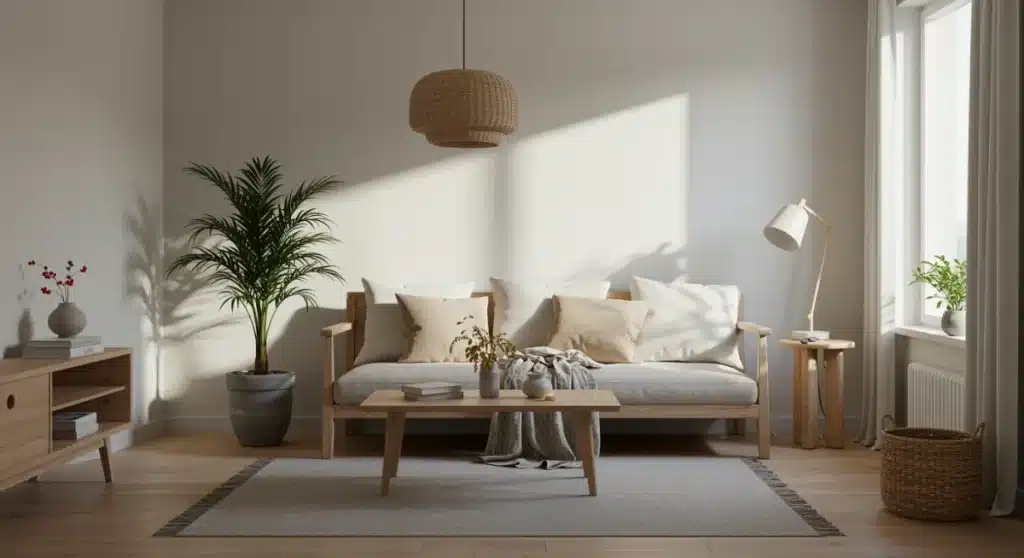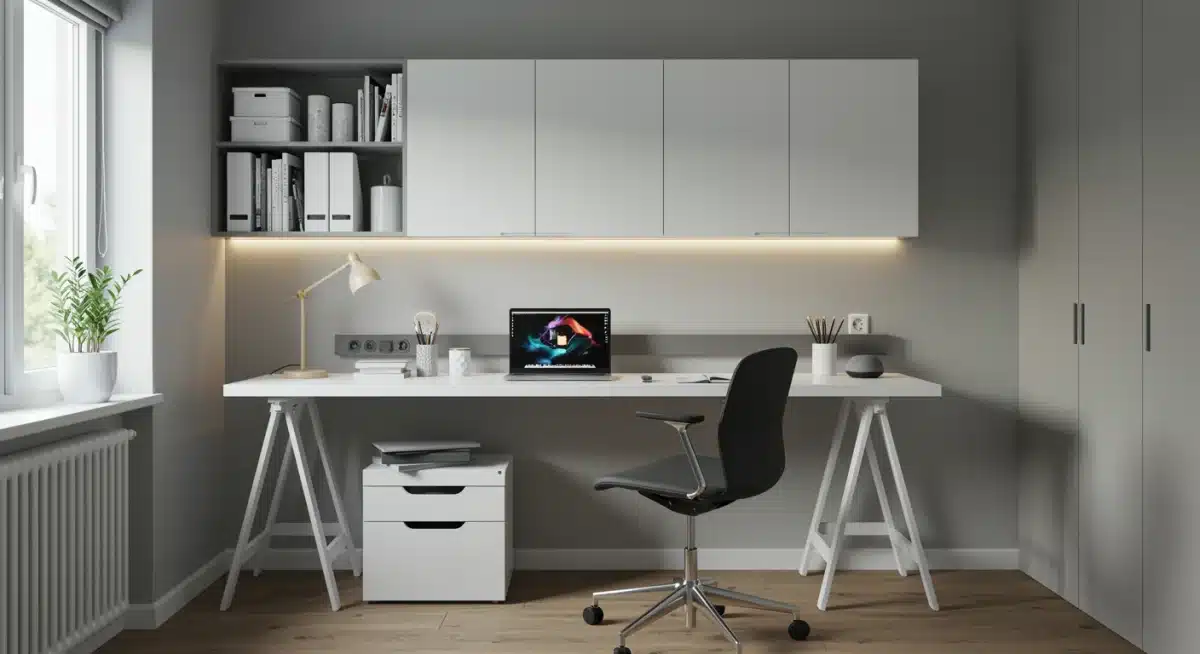Mindful Minimalism: Top 5 Home Trends for Americans in 2025

Mindful Minimalism Trends are significantly influencing American home design for 2025, emphasizing intentional living, sustainability, and decluttered, purposeful spaces.
Recent reports indicate a significant shift in American home aesthetics and functionality, pointing towards The Rise of Mindful Minimalism: 5 Key Trends Shaping American Homes in 2025. This movement prioritizes intentional living, sustainability, and well-being, moving beyond mere decluttering to embrace a more purposeful approach to home environments. What does this mean for your living space?
The Intentional Home: Purpose Over Possession
The concept of the intentional home is rapidly gaining traction. Americans are increasingly seeking spaces that serve a clear purpose, moving away from accumulating items for the sake of it. This trend emphasizes thoughtful curation, where every object in a home contributes to its overall function, aesthetic, or emotional well-being. It’s about creating environments that support daily life and personal values.
This shift is driven by a desire for less stress and more clarity. Consumers are reporting that a decluttered and purposeful home leads to increased peace of mind and enhanced productivity. As of late, retailers are noting a rise in demand for multi-functional furniture and storage solutions that blend seamlessly into living spaces, reflecting this deliberate approach to home design.
Curated Living Spaces
- Multi-functional Furniture: Pieces that serve multiple roles, such as sofa beds or tables with hidden storage.
- Meaningful Decor: Selecting items with personal significance rather than purely decorative purposes.
- Reduced Visual Clutter: Streamlining possessions to create a calm and ordered environment.
Embracing Quality Over Quantity
The focus has shifted from owning many items to investing in fewer, higher-quality pieces. This not only aligns with sustainability goals but also promotes longevity and appreciation for household goods. Durable materials and timeless designs are preferred, signaling a departure from fast-furniture trends.
Sustainable Sanctuaries: Eco-Conscious Living
Sustainability is no longer a niche concern but a mainstream expectation in home design. For 2025, American homes are evolving into sustainable sanctuaries, integrating eco-friendly materials, energy-efficient technologies, and practices that minimize environmental impact. This trend reflects a growing awareness of climate change and a collective desire to live more responsibly.
Reports from leading architecture and design firms confirm a surge in demand for sustainable building materials and practices. Homeowners are actively seeking ways to reduce their carbon footprint, from insulation choices to water-saving fixtures. This encompasses both the construction and ongoing maintenance of a home.
Eco-Friendly Materials
The use of recycled, reclaimed, and rapidly renewable materials is becoming standard. Bamboo, cork, recycled glass, and sustainably sourced timber are popular choices, offering both aesthetic appeal and environmental benefits. Manufacturers are responding by expanding their lines of eco-certified products, making sustainable options more accessible to the average consumer.
- Reclaimed Wood: Used for flooring, furniture, and decorative accents.
- Low-VOC Paints: Reducing indoor air pollution for healthier living.
- Energy-Efficient Appliances: Significantly lowering household energy consumption.
Water and Energy Conservation
Smart home technologies play a crucial role in managing resource consumption. Programmable thermostats, smart lighting systems, and water-saving showerheads are becoming common installations. Rainwater harvesting systems and greywater recycling are also seeing increased adoption, particularly in regions facing water scarcity. This proactive approach to resource management is a cornerstone of the mindful minimalist home.
Biophilic Design Integration: Connecting with Nature
Integrating biophilic design elements is a prominent trend shaping American homes in 2025. This approach seeks to connect inhabitants with nature, fostering a sense of well-being, reducing stress, and improving cognitive function. It’s about bringing the outdoors in, not just through plants, but through natural light, materials, and views.
Studies consistently demonstrate the positive impact of nature on mental and physical health. As such, designers are incorporating more natural elements into their plans, recognizing the profound benefits for occupants. This extends beyond mere aesthetics, aiming to create environments that genuinely nurture the human spirit.
Natural Light Optimization
Maximizing natural light is a key component of biophilic design. Large windows, skylights, and open-plan layouts are favored to flood interiors with daylight, reducing reliance on artificial lighting. Strategic placement of mirrors can also enhance light distribution, making spaces feel brighter and more expansive.
Indoor Greenery and Water Features
Plants are essential to biophilic design, purifying air and adding vibrant life to rooms. Vertical gardens, living walls, and carefully placed potted plants are common. Small indoor water features, such as tabletop fountains, introduce soothing sounds and a sense of tranquility, further enhancing the natural connection.
Decluttered Digital Spaces: Tech-Integrated Serenity
As our lives become increasingly digital, the trend of decluttering digital spaces, while seamlessly integrating necessary technology, is emerging as a critical aspect of mindful minimalism. For 2025, American homes are evolving to hide unsightly wires and devices, creating serene environments where technology serves, rather than overwhelms, the living experience. This means smart homes that feel intuitive and unobtrusive.
Consumers are demanding solutions that integrate technology elegantly, allowing for a high-tech lifestyle without visual clutter. The focus is on functionality and ease of use, ensuring that smart devices enhance daily routines without becoming distractions. This move reflects a broader desire to reclaim digital peace amidst constant connectivity.
Invisible Technology Solutions
The market is seeing an increase in products designed to conceal technology. Wireless charging stations built into furniture, hidden speakers, and integrated projection systems are becoming popular. The goal is to make technology disappear when not in use, preserving the minimalist aesthetic of the home.
- Smart Home Hubs: Centralized controls that manage devices without visible clutter.
- Cable Management Systems: Hiding wires and power strips for a cleaner look.
- Wall-Mounted Displays: Televisions and monitors that blend into the decor.
Streamlined Digital Habits
Beyond physical integration, mindful minimalism extends to digital habits. This involves organizing digital files, unsubscribing from unnecessary emails, and consciously limiting screen time. The objective is to create a harmonious relationship with technology, where it supports life without becoming a source of stress or distraction.

Wellness Zones: Prioritizing Health and Relaxation
The creation of dedicated wellness zones within American homes is a significant trend for 2025, reflecting a deeper commitment to personal health and relaxation. Mindful minimalism encourages spaces that actively support physical and mental well-being, moving beyond traditional bedrooms and bathrooms to include areas specifically designed for rejuvenation.
Recent surveys indicate that homeowners are increasingly allocating space for activities like meditation, yoga, reading, or simply quiet contemplation. This shift highlights a growing recognition of the home’s role as a sanctuary for self-care and mental restoration. The design of these zones focuses on comfort, tranquility, and sensory appeal.
Dedicated Relaxation Nooks
These spaces are typically designed with minimal distractions, featuring comfortable seating, soft lighting, and perhaps a small collection of books or a yoga mat. The color palette often includes calming neutrals and natural tones, fostering an atmosphere of peace. Access to natural light and views of greenery further enhance the therapeutic qualities of these zones.
- Meditation Corners: Simple, uncluttered spaces for mindfulness practices.
- Reading Retreats: Cozy spots with comfortable chairs and good lighting.
- Home Gyms/Yoga Studios: Dedicated areas for physical activity and stretching.
Sensory-Rich Environments
Wellness zones often incorporate elements that engage the senses in a soothing way. Aromatherapy diffusers, soft textures, calming music systems, and natural scents contribute to an immersive experience. The aim is to create a holistic environment that supports both mental clarity and physical ease, making self-care an integral part of daily home life.
Adaptive Living: Versatility in Home Design
Adaptive living is an emerging trend in American homes for 2025, emphasizing versatility and flexibility in design. As lifestyles evolve and needs change, homeowners are seeking spaces that can easily transform to accommodate different functions. This approach aligns perfectly with mindful minimalism, promoting efficiency and reducing the need for specialized, single-purpose rooms.
The pandemic significantly accelerated the demand for adaptable spaces, as homes suddenly needed to serve as offices, schools, gyms, and entertainment hubs. This has led to innovative design solutions that maximize space utility without compromising aesthetics or comfort. The focus is on intelligent layouts and modular elements that can be reconfigured with ease.
Modular and Flexible Furniture
Furniture designed for adaptability is key to adaptive living. Sectional sofas that can be rearranged, tables that extend or collapse, and shelving units that can be reconfigured are becoming popular. These pieces allow for quick transitions between different activities, making small spaces feel larger and more functional.
- Murphy Beds: Allowing bedrooms to convert into offices or living areas.
- Movable Partitions: Creating temporary rooms or open-plan layouts as needed.
- Storage Ottomans: Providing seating and hidden storage simultaneously.
Multi-Functional Rooms
The traditional concept of a single-purpose room is diminishing. Instead, spaces are designed to host multiple activities throughout the day. A dining room might double as a workspace, or a living room could include a dedicated area for creative hobbies. This mindful utilization of space reflects a desire for homes that truly support a dynamic modern lifestyle.
| Key Trend | Brief Description |
|---|---|
| Intentional Home | Prioritizing purpose and meaning over excessive possessions in home design. |
| Sustainable Sanctuaries | Integrating eco-friendly materials and energy-efficient practices for responsible living. |
| Biophilic Design | Connecting interiors with nature through light, plants, and natural elements for well-being. |
| Wellness Zones | Dedicated home areas for relaxation, meditation, and physical or mental rejuvenation. |
Frequently Asked Questions About Mindful Minimalism Trends
Mindful minimalism in home design goes beyond decluttering; it’s about creating intentional spaces that support well-being, sustainability, and purpose. It involves carefully curating possessions and designing environments that foster peace, functionality, and a connection to nature, reflecting personal values rather than just aesthetics.
Sustainability is a core pillar of mindful minimalism. It emphasizes eco-conscious choices in materials, energy consumption, and waste reduction. This includes using recycled or reclaimed materials, investing in energy-efficient appliances, and adopting practices that minimize environmental impact, creating a home that is both beautiful and responsible.
Absolutely. Mindful minimalism embraces technology, but with a focus on seamless integration and reduced visual clutter. This means utilizing smart home systems, hidden charging stations, and concealed devices that enhance functionality without disrupting the serene aesthetic. The goal is technology that serves quietly and efficiently.
Wellness zones are dedicated areas within the home designed specifically for relaxation, mental clarity, and self-care. These can include meditation corners, reading nooks, or spaces for yoga. They typically feature calming colors, soft lighting, and minimal distractions to foster an environment conducive to rejuvenation and stress reduction.
Adaptive living is crucial for 2025 homes because it provides flexibility and versatility. Modern lifestyles demand spaces that can easily transform to meet changing needs, such as a dining area becoming a workspace. This trend utilizes modular furniture and multi-functional layouts, ensuring homes remain efficient and relevant as life evolves.
What This Means
The ongoing shift towards mindful minimalism signifies a deeper cultural rethinking of home and lifestyle in America. These trends, currently shaping 2025, indicate a sustained movement away from consumerism towards intentionality, well-being, and ecological responsibility. Homeowners and designers alike are now prioritizing spaces that not only look good but also feel good and do good for the planet. Expect to see continued innovation in sustainable materials and smart, adaptable home solutions as these values become even more entrenched in daily living.





